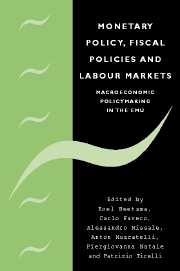Book contents
- Frontmatter
- Contents
- List of figures
- List of tables
- List of contributors
- Acknowledgements
- Editors' introduction
- Part I Monetary policy
- Part II Fiscal policies
- 5 The interaction between monetary and fiscal policies in a monetary union: a review of recent literature
- 6 Independent or coordinated? Monetary and fiscal policy in EMU
- 7 Interaction of fiscal policies in the euro area: how much pressure on the ECB?
- 8 The macroeconomic impact of different speeds of debt stabilisation in EMU
- 9 Fiscal shocks and policy regimes in some OECD countries
- 10 Monetary and fiscal policy interactions over the cycle: some empirical evidence
- Part III Labour markets
- Index
5 - The interaction between monetary and fiscal policies in a monetary union: a review of recent literature
from Part II - Fiscal policies
Published online by Cambridge University Press: 22 September 2009
- Frontmatter
- Contents
- List of figures
- List of tables
- List of contributors
- Acknowledgements
- Editors' introduction
- Part I Monetary policy
- Part II Fiscal policies
- 5 The interaction between monetary and fiscal policies in a monetary union: a review of recent literature
- 6 Independent or coordinated? Monetary and fiscal policy in EMU
- 7 Interaction of fiscal policies in the euro area: how much pressure on the ECB?
- 8 The macroeconomic impact of different speeds of debt stabilisation in EMU
- 9 Fiscal shocks and policy regimes in some OECD countries
- 10 Monetary and fiscal policy interactions over the cycle: some empirical evidence
- Part III Labour markets
- Index
Summary
Introduction
The creation of the European Monetary Union (EMU) has given a new impulse to research on the interactions between monetary and fiscal policies. The key considerations in this research concern (1) the question of how fiscal policy impacts on the credibility of the common monetary policy and (2) to what extent fiscal policy can or should take over the role of monetary policy in stabilising country-specific shocks.
Central bankers often regard fiscal discipline as a prerequisite for a credible monetary policy. Accordingly, the Delors Report (1989), which provides the blueprint for the foundation of a monetary union in Europe, emphasised fiscal discipline as a prerequisite for a successful monetary union. This view has found its way into the Treaty on the European Union (the ‘Maastricht Treaty’), which sets out the institutional framework for EMU. The Treaty includes restrictions on deficit and debt, both as an entry criterion for EMU and as a permanent provision for countries to stick to, once membership is granted. Violation of these restrictions might activate the so-called ‘Excessive Deficit Procedure’.
The provisions for fiscal policy in the Treaty have failed to mitigate concerns about fiscal discipline in EMU. The reason is that, once countries have entered EMU, the Treaty provides only little scope for forcing fiscal discipline on the union participants. As a result, Germany, frightened by the possibility that undisciplined fiscal policies might undermine the common monetary policy, floated the idea of a ‘stability pact’.
- Type
- Chapter
- Information
- Monetary Policy, Fiscal Policies and Labour MarketsMacroeconomic Policymaking in the EMU, pp. 91 - 133Publisher: Cambridge University PressPrint publication year: 2004
- 16
- Cited by



